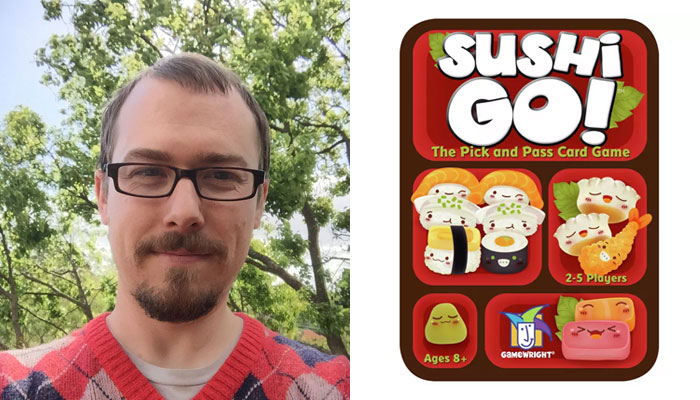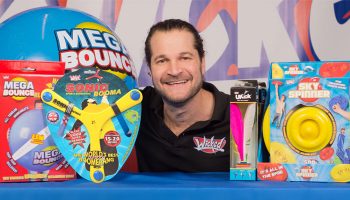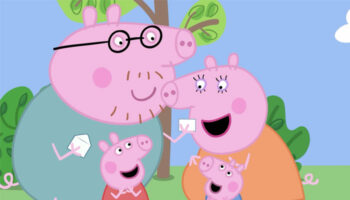Prolific game designer Phil Walker-Harding on 10 years of Sushi Go!

Phil, it’s great to catch up. Sushi Go! is celebrating its 10th anniversary this year. We’ve covered its origin story in a previous chat, but something we didn’t speak about was that you’d actually self-published the game before it found a home with Gamewright…
Yes! So technically this year is the 11th anniversary because Gamewright published it in 2014, but I self-published it in 2013. I’d self-publishing a handful of games by that point – very small print runs. Dungeon Raiders was the first game I’d done a professional print-run of… Before that, I was literally hand-making them.
And you self-published Sushi Go! through crowdfunding?
That’s right. I ran a campaign on Indiegogo – this was before Kickstarter was in Australia. Then I did a print run of 3,000 and one of those copies ended up in the hands of Jason Schneider who was at Gamewright at the time.

Did it get to him organically or did you pitch it?
Organically! I’d self-published Archaeology which Z-Man then picked up, and I had hopes that some of my other self-published stuff would get picked up… But no, I didn’t pitch Sushi Go!. I got an email out of the blue… I think Jason had played it at his game group. It was a total surprise, but at the same time, I was a big fan of Gamewright’s card games – and still am – so I’d used that as a bit of a template for what I was doing. No more than 110 cards, family-friendly gameplay, cute, bright graphics… They were kind of my inspiration for the game, so the fact it connected with Jason was gratifying.
Amazing. Was there much of an evolution between your self-published version and the Gamewright version?
No, we didn’t make any rules changes. It was new art and graphic design and fresh packaging – that made a big different. The art from Nan Rangsima was extra level of cute and even the tin… I know not all hobby gamers like tins, but a tin that looked like a little bento box really popped on shelf.

Did your experience with Gamewright and Sushi Go! push you to pitch more?
Yes – Sushi Go! was the first game of mine to bring in regular royalties. It sold consistently for a number of years quite well and as a result, I could commit more time to game design. It was a major part of me becoming a game designer full time. You need regular royalties coming in to do that and Sushi Go! was a big building block in me getting to that point. I didn’t fully take that leap for another year or so, but it was a big part of that decision because it seemed like this would keep selling reasonably well for a while.
What were you doing before going full time as a game designer?
When Imhotep was nominated for the Spiel, that was when I thought: ‘I should really be devoting more time to this.’ At that stage I was doing my Master’s in Theology and I was doing a bit of teaching.
I hoped you would say: “I was a sushi chef.” Some clear and obvious connection to Sushi Go!
Ha! No, but I was a frequenter of sushi restaurants! I’ve never made sushi!
On that, was the theme for the game always sushi, or do you have prototypes somewhere for Toad Go! or Pizza Go!?
Ha! Well, I have the file for the very first prototype of Sushi Go! that I did and it was themed around baked goods – cookies and pie and cake… I don’t think I really believed in that theme; it was just art I could slap on it to start playtesting it. I remember thinking about the theme for this very abstract card game and I thought ‘What is something that works in relation to drafting around the table?’ I’d recently had a Sushi train meal, so I thought: ‘Ah, sushi goes around the table!’ It seemed perfect. From the second prototype on it was always sushi.

Sushi Go! is a very accessible game and it’s lived in mass market retailers as well as being embraced by the ‘hobby’ too. What are your thoughts on the lines between mass market games and hobby titles?
It’s interesting – and there is a difference between ‘mass’ in the US and ‘mass’ in Europe. Gamewright has a foot in both camps. Some of their more popular games do really big numbers and are absolutely what you would call a ‘mass market success’. But they also do Matt Leacock co-op games, that sit more in hobby.
I’ve met more designers now who work solely in the mass space and it’s a very different discipline. I don’t really like the ‘Eurogame’ tag, but I still think of myself as someone who got into German games in the 2000s and I design in that world… That’s how I view myself – I’m just on the lighter side of that. And with Sushi Go!, when I was designing it I knew it was a filler, but I saw it as a ‘Eurogame filler’. I enjoy lighter games and I enjoy playing with a wide range of different people, so my games tend to be somewhat mass-friendly… But I don’t think I can design an Exploding Kittens or Cards Against Humanity style of mass market game. That’s not how my brain works.
Then in Europe, there’s a longer tradition of ‘hobby’ games being in the home, so perceptions of mass market is different. It’s an interesting division – they are different disciplines but there are crossover points.
Has your mass market experiences shaped how you design hobby games?
100%. Once you’ve had a game in somewhere like Target or Walmart in the US, you become aware of what a mass audience actually thinks of your game!
In the early days of Sushi Go!, I’d see a lot of discussions online about how complex it is… If you’re someone that hasn’t played modern German games and you’ve just picked up this cute card game, it’s got lots of different ways to score… It’s quite ‘mathy’. You need to learn multiple different cards… Chopsticks seems to trip everyone up when they first play! I still get questions about Chopsticks.

If you look at reviews on amazon, there’s plenty of people who struggle to learn the game out of the box. If you watch a game or get taught the game, it’s fine… We in the hobby take a lot of things for granted about learning a game out of the box. People who don’t play a lot of games just don’t have the same stamina that we’ve built up to sit down with a rulebook for 10 or 20 minutes.
Once you’re aware of that discussion, you get a good idea of what can trip up non-hobby gamers in the rules – and what might ruin their first play of a game. I’ve certainly honed my radar for that.
In terms of what helps you do game design full-time, do you look at mass market games as something that can be useful in sustaining this type of career?
No, because the difference between a full-time designer and a part-time designer isn’t what shops your games are sold in. It’s more a question of: Do you have an evergreen that’s selling tens of thousands of units every year for many years? That’s the big difference – and that can happen in the hobby space. There’s plenty of hobby games that do that – and some do find their way into Target… Look at the likes of 7 Wonders of Wingspan. They’re not simple mass market games. That’s the real difference.
If you go hunting for anything other than making a really good game, that’s a danger. That always has to come first. Going into things thinking ‘This would be great for Target’ is tricky because some mass market games go into these stores for a very short amount of time. So it’s not a case of mass market or hobby – it’s about making a game that connects with its audience so well that it sells for five years or 10 years… That audience might be mass market, or it might be birdwatchers who can handle a complex 90-minute game.
Great answer. Now, when did you become aware that Sushi Go! was going to be a bit special in terms of finding an audience?
The first penny to drop was my second royalties being higher than my first royalties! Other royalties I’d had up to that point had just enjoyed a steady decline. I was like: ‘Oh, they can go up!’ That was the first thing.
Being in Australia, I’m quite removed from the hobby on the ground in North America. Two or three years after Sushi Go! launched, I was on Instagram and I had a look at the #SushiGo tag – there were thousands of photos of people playing the game from all across the US. I obviously hadn’t seen that on BoardGameGeek, I hadn’t seen that at my local games meet-up and so that was a window into seeing the game being played in lots of different places. That’s when I knew it was bigger than I’d realised.

Did it open doors to publishers who then wanted to see your other concepts?
Every game you have out that a publisher recognises probably does help open doors a little bit. I actually felt it more with Imhotep, because that was in the hobby space and I was pitching mainly to hobby publishers – and still do. After Imhotep was nominated for the Spiel, I had a publisher email me asking to show them my game concepts. That was the first time that had happened.
It’s about recognition, so I think Sushi Go! probably helped in some way too – but this isn’t Hollywood and the name of the designer doesn’t sell a game on its own. No publisher I know takes that risk.
I don’t sense any ego on you Phil so this may be a redundant question, but have you seen Sushi Go! shape or influence the industry in any way since it arrived 10 years ago?
Yeah – that’s hard for me to answer, but there’s two things that it may have influenced. One is the pairing of cute artwork with some nice decision-making. That’s something I see more and more, and that’s great. You can have a game that takes itself seriously as a ‘game’, but that also looks fun and silly. I’m not sure that was as much the case back when Sushi Go! launched.
I’ve always played lighter games, but over the last 10 years I’ve seen more hobbyists who play 90-minute strategy games say: ‘You know what, some of these sillier little games are awesome too!’ I think Sushi Go! maybe played a part in the rise of that appreciation for ‘filler games’.

Absolutely. Sushi Go! has sparked spin-off games like Sushi Go Party! and Sushi Go! Spin Sum for Dim Sum. What dictates when you dip back into this world for future games?
It’s led by Gamewright. They have a strong sense of the market and how to avoid oversaturating it. They know when the time is right for another Sushi Go! title. With Sushi Go Party!, they were looking for the next game in the series and I pitched that. Then they asked for a dice game, and it took me a long time to deliver Sushi Roll. It was very hard for me to make an enjoyable dice game!

With Spin Sum for Dim Sum, other designers – Ken Gruhl and Quentin Weir – pitched Gamewright a dim sum game and it lined up with the right time for a new Sushi Go! game, so they themed it that way. For the last few years, we’ve been in a constant conversation about what the next thing could be… There’s lots of ideas circulating.

How does creating fresh Sushi Go! concepts compare to your process for designing totally new games?
I actually like these kinds of design briefs. I find them helpful. If someone says to me: ‘Can you come up with dice version of this?’ That’s a nice challenge and it can be useful to have boundaries… I don’t always find designing from a blank page easy.
Doing Sushi Go Party! made me realise that the pick-and-pass mechanism is interesting – and that there’s quite a lot you could do with it… And plenty of other designers have done really cool things with it too. So I find it an enjoyable challenge to try and do something new in the Sushi Go! world.

Do you think about the scope for a game to have expansions and spin-offs when designing new titles?
Well, if a game is a hit, publishers are quick to turn it into a series – you see this in the industry more and more. As long as each subsequent game in the series deserves to exist, then it’s great. It’s hard to have longevity on the shelf in the current market; games come and go so quickly… This is a way to keep a game in people’s minds for longer, and that’s a good thing. I’m always fascinated to see what the next Azul or Ticket to Ride game will be.
If you have a game that’s a moderate success, thinking about spin-off games or other games in the series can be a great thought experiment. It can lead you down some interesting design paths and if it comes off, it can help a game stay front of mind for longer. That’s certainly the case with Sushi Go!.
So yes, if a game’s core conceit or mechanism is strong enough, I think it’s a good idea to iterate on it and think about spin-offs.

We should talk about this beautiful 10th anniversary edition of Sushi Go!. It looks great and is packed with terrific components – and some neat surprises… Including four packs of dessert cards which are new and can be used in the game – how did these come about?
I’m always thinking about new Sushi Go! cards. Gamewright proposed the 10th anniversary edition and when they mentioned wanting new cards, I dived into my file and found some cards that would work. We picked some of the most whimsical ones…
Two of them came from cool production ideas that Gamewright had, like the thermo-reactive ink. They said: ‘There’s a cool ink we’ve been playing around with that only shows up once you’ve heated it up with your hand – could we bring that into the game?’ Immediately I thought about some kind of frozen dessert.

It was the same with the dice. They thought it would be cool to reveal dice – so I designed a Sushi Go! card that uses dice… So they had a lot of fun product ideas that I bounced off, and I also had some card ideas stored up.
Phil, before we wrap up, I wanted to ask about one of your new games with Gamewright – Wrath of Fire Mountain, co-designed with Eric Lang. How did this come about?
I’ve known Eric for a while. While he was at CMON he signed one of my games, Gizmos. I met him through that and we enjoyed working together on that. When he finished there, he said: “Hey, if you ever want to work on something, let me know.” I had this old design that goes back 15 years… I could never get it working and three or four publishers had passed on it over the years.

The concept was an area control game in the style of El Grande – but you’re playing on a slide puzzle board… So you can slide the board to change the layout of the regions – you can break them up or bring them together.
I could never make it work, so I said to Eric: “You do area control pretty well! What do you think of this?” That began two years of Zoom design sessions, and we’d work on it when we met up at conventions… And Eric’s style unlocked the design.

In what sense?
I’m very much a “German game” designer. There are certain places my brain doesn’t go to for solutions that his brain does, because he has designed across different milieus. It was a really good collaboration because of that.
I’ll never forget when Eric said: “You know what needs to drive this whole game – Yahtzee!” I was like: “Nah! It’s going to be nice, organised card play and that will drive the action.” He said: “No, it’s going to be dice and there’s going to be three re-rolls.” It was absolutely the right decision! The game needed a lot of ability to plan, but it absolutely needed a lot of uncertainty to crop up every turn. Together that kept the slide puzzle craziness on the rails.
It took a lot of time to work it out, but it all came together.

A nice example of a mass market solution to a more complex game problem.
When Buffalo were interested, we consciously decided to make it a 10-year-old’s dream game. Let’s include dinosaurs, a volcano and simple rules. Before Buffalo signalled their interest, we hadn’t settled on what the complexity level should be.
Fantastic. I have two final questions for you! First, what’s your most underrated game?
The two games where I felt like I really succeeded in my own goals for the games – but that only did okay – are Super Mega Lucky Box and Museum Suspects.

With Super Mega Lucky Box, I set out to make ‘bingo with decisions’ and it landed where I wanted it to. I’m still happy with that game. Museum Suspects is a deduction game with Blue Orange that I was really happy with, but it didn’t find much of an audience. With most of my games, I see all the faults – but I’m very happy with those two!
I’ll seek them out! Last question, what titles are on the way next from you?
I have two games on the way with Mojito Studios… One is a co-op game for kids called Sinister Institute. It’s about teen wizards taking on an evil sorcerer in a swamp. My other one with them is called Tropicalia. It’s a mid-weight family Eurogame that’s really fun.

My other one is with AEG called Misfit Heroes. The game comes with 100 cards and 100 transparencies. Before you play, you mix up the transparencies and randomly put them on cards. The cards are attributes and the transparencies are characters, so when you put them together you create a unique card… So the game sort of autogenerates a different deck of 100 characters each time you play. That was a lot of work!
It sounds like a lot of work!
Prototyping that thing was a nightmare! It all came from an idea that came to me when KeyForge came out. I’m not a big TCG person but I got into KeyForge and I loved the system… I started thinking about how you’d make a TCG, and how you’d generate hundreds of card powers. Then I thought: ‘Why not make the game generate the cards for me?’ That’s where the idea came from. AEG did a huge amount of development on it too.

I’m excited about it – I feel like I have very good ideas like that very rarely! One was ‘7 Wonders but I can teach my grandma’ and that became Sushi Go!. With that I felt, this is a good idea, I should go and do it. The idea for Misfits Heroes is another like that… I get an idea like that once every few years, so when you get one you’ve got to find a way to make it happen.
Amazing. I look forward to playing it. Thanks again Phil.
–
To stay in the loop with the latest news, interviews and features from the world of toy and game design, sign up to our weekly newsletter here

























